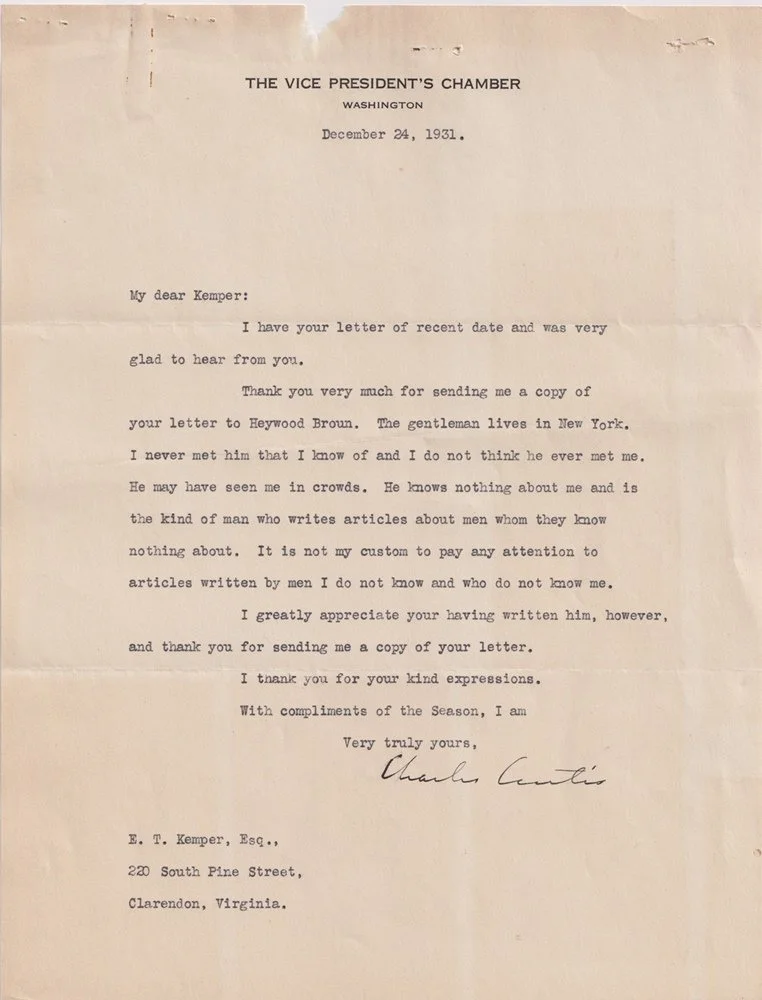
Curtis, Charles Vice President
Charles Curtis – The Vice President brushes off press criticism.
An unusual revealing letter from sitting Vice President Charles Curtis, written on Christmas Eve 1931, offers a candid look at his reaction to criticism. Curtis thanks Elmer Kemper for sending along a critical article with a dismissive tone that hints at deeper irritation than he admits to:
“I never met him that I know of and I do not think he ever met me. He may have seen me in crowds. He knows nothing about me and is the kind of man who writes articles about men they know nothing about. It is not my custom to pay any attention to articles written by men I do now and who do not know me.”
Curtis’s emphatic repetition “he does not know me” suggests the sting of public criticism affected him more than he let on. This is a better than average letter with revealing personal content that is unusual for high-ranking officials, particularly during the embattled Hoover Administration.
Condition. The letter is on an 8 x 10.5 sheet of Vice President’s Chamber stationery. The top blank margin shows staple holes, a paperclip mark and a slight loss of paper, in one spot. Those are small blemishes for a letter with good content.
Curtis’s political career spanned decades. First elected to Congress in 1893 he would serve three terms in the U.S. Senate, including four years as Senate Majority Leader during Calvin Coolidge’s elected term of 1925-1929. Though he opposed Hoover for the 1928 Republican nomination, Curtis was selected by the Convention to be Hoover’s running mate. His legacy as Vice President is defined not for what he did as vice president but his identity. Curtis remains at the only Vice President of Native American decent. His mother was one-quarter Kaw and Curits was raised for a period on the Kaw reservation in Kansas.
,
Charles Curtis – The Vice President brushes off press criticism.
An unusual revealing letter from sitting Vice President Charles Curtis, written on Christmas Eve 1931, offers a candid look at his reaction to criticism. Curtis thanks Elmer Kemper for sending along a critical article with a dismissive tone that hints at deeper irritation than he admits to:
“I never met him that I know of and I do not think he ever met me. He may have seen me in crowds. He knows nothing about me and is the kind of man who writes articles about men they know nothing about. It is not my custom to pay any attention to articles written by men I do now and who do not know me.”
Curtis’s emphatic repetition “he does not know me” suggests the sting of public criticism affected him more than he let on. This is a better than average letter with revealing personal content that is unusual for high-ranking officials, particularly during the embattled Hoover Administration.
Condition. The letter is on an 8 x 10.5 sheet of Vice President’s Chamber stationery. The top blank margin shows staple holes, a paperclip mark and a slight loss of paper, in one spot. Those are small blemishes for a letter with good content.
Curtis’s political career spanned decades. First elected to Congress in 1893 he would serve three terms in the U.S. Senate, including four years as Senate Majority Leader during Calvin Coolidge’s elected term of 1925-1929. Though he opposed Hoover for the 1928 Republican nomination, Curtis was selected by the Convention to be Hoover’s running mate. His legacy as Vice President is defined not for what he did as vice president but his identity. Curtis remains at the only Vice President of Native American decent. His mother was one-quarter Kaw and Curits was raised for a period on the Kaw reservation in Kansas.
,
